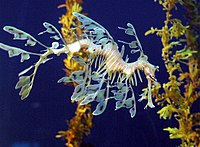
Photo from wikipedia
Suction-feeding in fishes is a ubiquitous form of prey capture whose outcome depends both on the movements of the predator and the prey, and on the dynamics of the surrounding… Click to show full abstract
Suction-feeding in fishes is a ubiquitous form of prey capture whose outcome depends both on the movements of the predator and the prey, and on the dynamics of the surrounding fluid, which exerts forces on the two organisms. The inherent complexity of suction-feeding has challenged previous efforts to understand how the feeding strikes are modified when species evolve to feed on different prey types. Here, we use the concept of dynamic similarity, commonly applied to understanding the mechanisms of swimming, flying, walking and aquatic feeding. We characterize the hydrodynamic regimes pertaining to (i) the forward movement of the fish (ram), and (ii) the suction flows for feeding strikes of 71 species of acanthomorph fishes. A discriminant function analysis revealed that feeding strikes of zooplanktivores, generalists and piscivores could be distinguished based on their hydrodynamic regimes. Furthermore, a phylogenetic comparative analysis revealed that there are distinctive hydrodynamic adaptive peaks associated with zooplanktivores, generalists and piscivores. The scaling of dynamic similarity across species, body sizes and feeding guilds in fishes indicates that elementary hydrodynamic principles govern the trophic evolution of suction-feeding in fishes.
Journal Title: Proceedings of the Royal Society B: Biological Sciences
Year Published: 2022
Link to full text (if available)
Share on Social Media: Sign Up to like & get
recommendations!